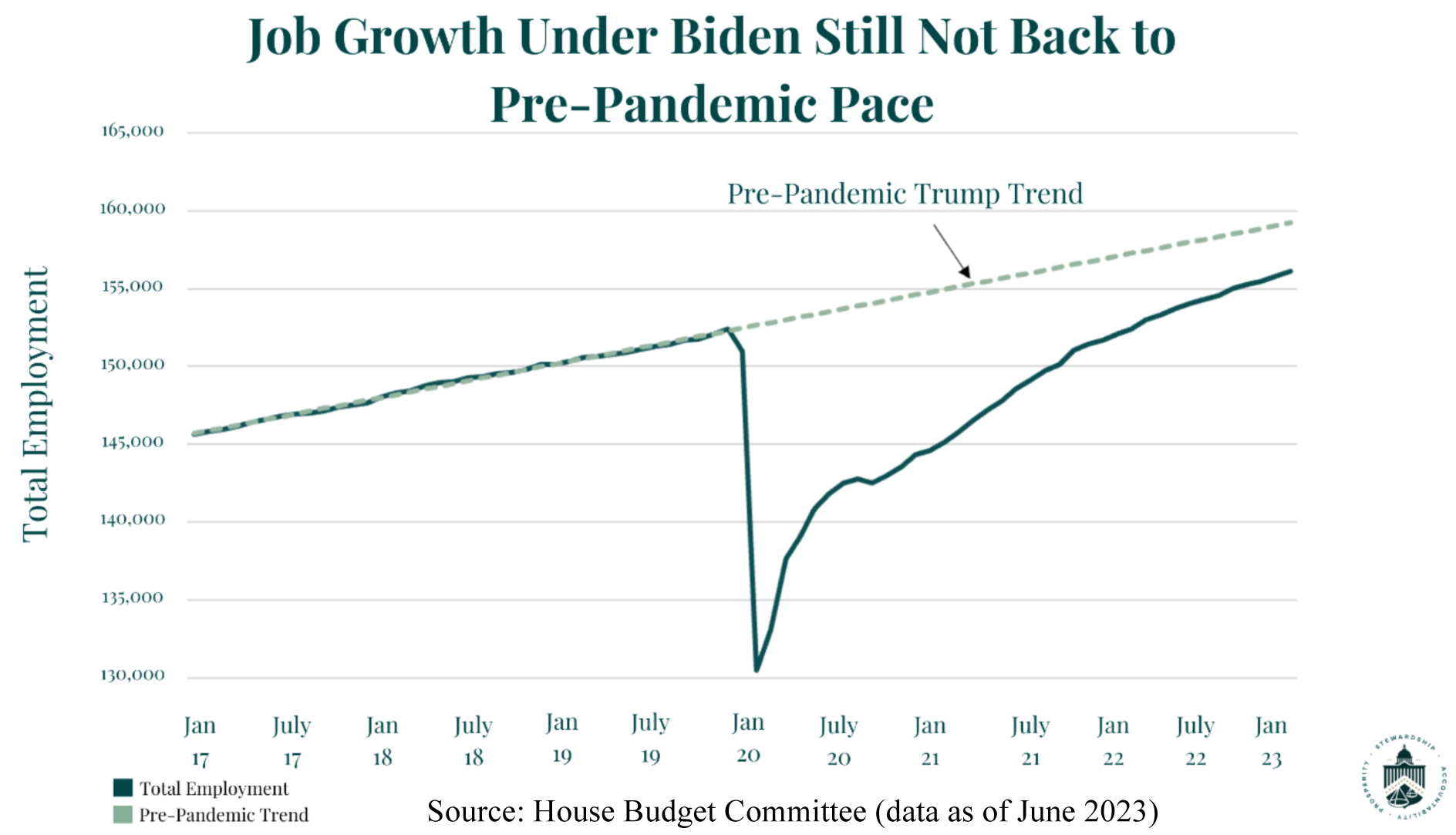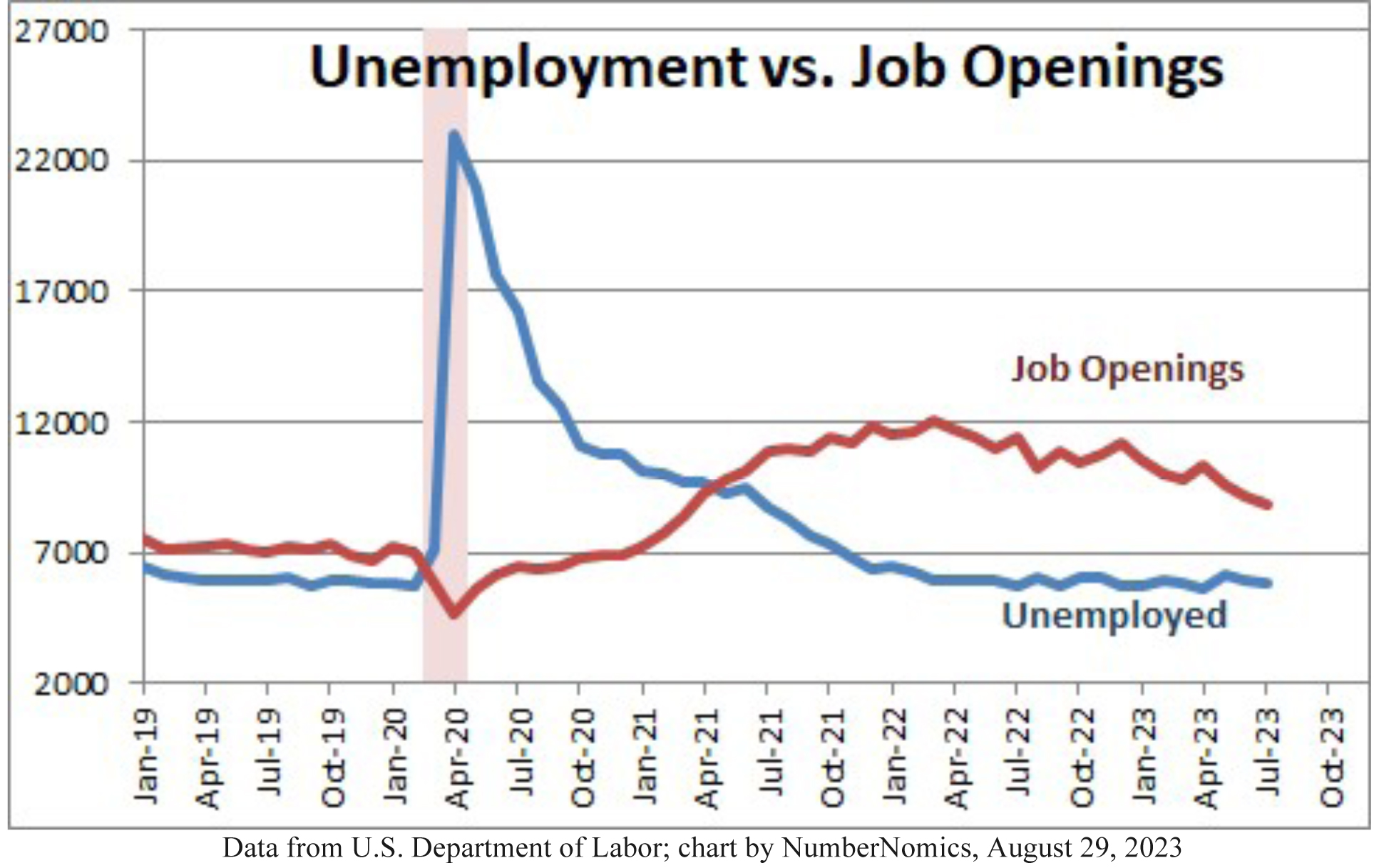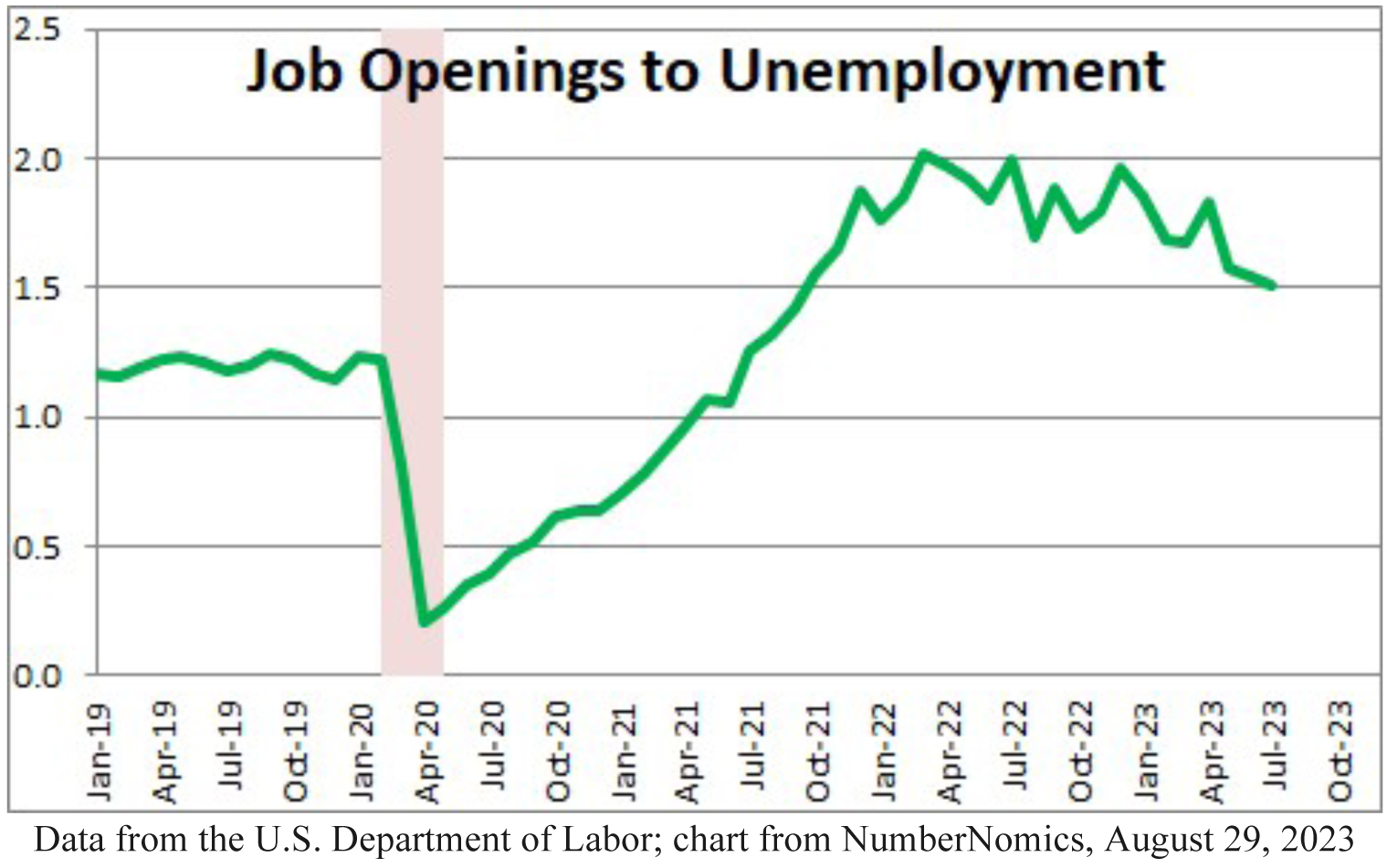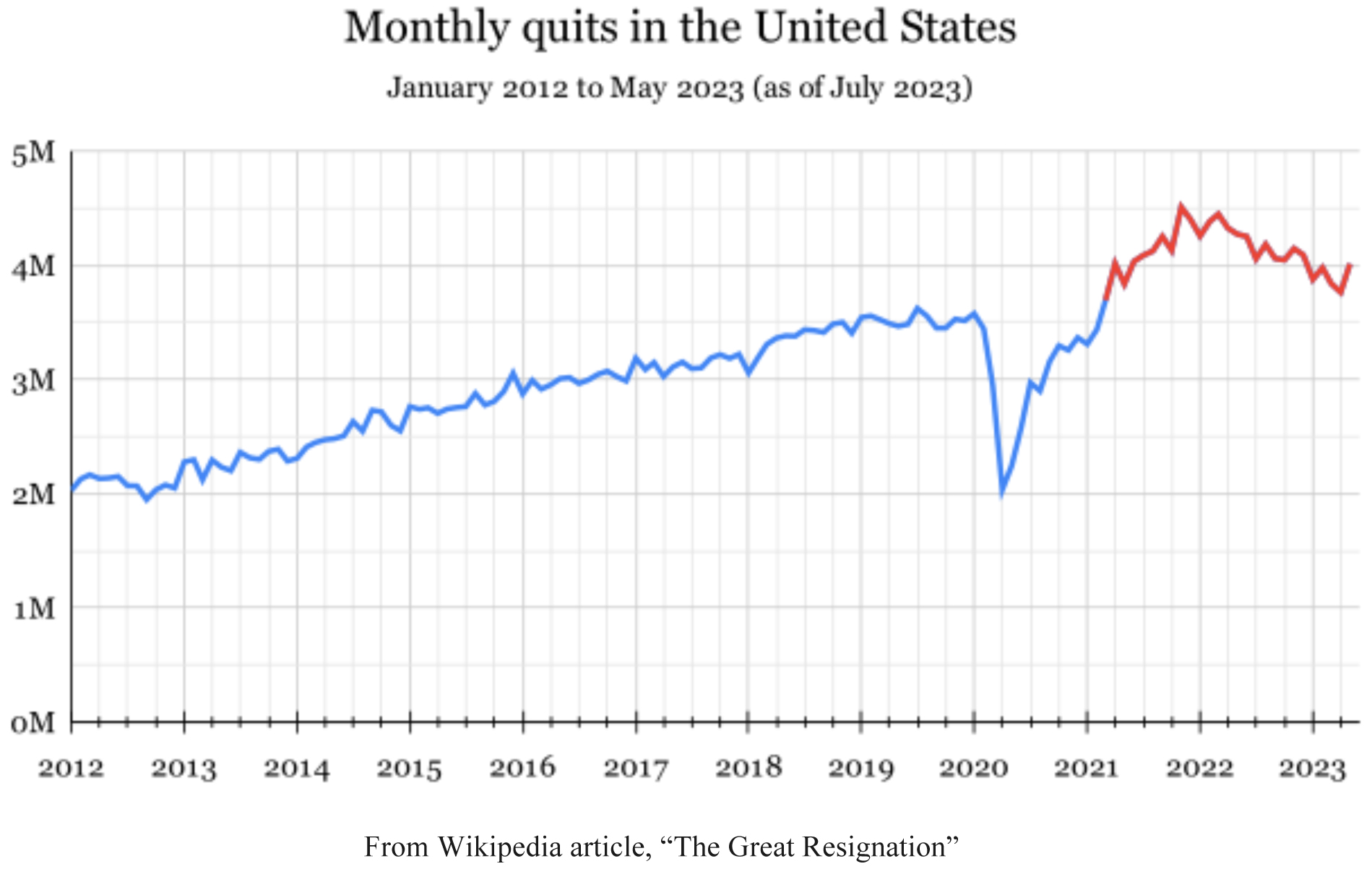by Gary Alexander
September 6, 2023
The August unemployment report was released at 5:30 am (my time) on Friday, September 1. Do we really expect all the bean counters at the U.S. Labor Department to calculate ALL the job changes in the month of August at the crack of dawn on the first day of September? Do companies really report, in a timely manner at the close of business on August 31, about everybody they hired and fired that day, that week?
As a case in point, the original June U.S. Labor Department report on new jobs was 209,000, but the August revision to the June count was ratcheted lower by 50% – to 105,000 – making June the smallest monthly gain since December 2020. What happened to those 104,000 jobs that never existed? If a key data metric can be off by 50% two months later, why report it at all? Why not wait until it is accurate?
What’s even more amazing, ADP reported last Wednesday (August 30) that 177,000 private payroll jobs were created in August – while there were still two days left in August! The media noted that the 177,000 total was “slower than normal.” Well, of course! The month was not yet over. What’s the hurry, everyone?
Upon release of Friday’s downbeat jobs report, President Biden repeated what the Washington Post called a “bottomless Pinocchio,” that “we’ve added 13.5 million new jobs since I took office…. We created more jobs in two years than any president ever created in four years.” But less than a minute later, he told the truth: “We’ve recovered all the jobs lost during the pandemic. We’ve added a million more new jobs!” Amazingly, few press “fact checkers” highlighted the 12.5 “jobs created” gap in the President’s speech.

Graphs are for illustrative and discussion purposes only. Please read important disclosures at the end of this commentary.
And not to get too Clintonesque on you, but all this brouhaha over jobs begs the question of what a job is? In these widely watched monthly reports, a “job” can be part-time work, or a temporary fill-in position, or a million-dollar CEO placement. Some jobs are more “sticky” and higher quality than other semi-jobs.
We could resolve these confusing and conflicting numbers by: (1) waiting until the numbers are accurate; (2) measuring only full-time jobs, with part-time jobs measured in fractions; and (3) ignoring algorithms for seasonal adjustments. To be “seasonal,” just compare any given month to the same month a year ago.
Job Openings Still Outnumber Job Seekers by 50%
Job Openings peaked at over 12 million in March 2022. As the economy slowed, those openings dipped to 9.6 million as of June 2023 and then dropped to 8.8 million in July, but that’s still a big world of opportunity, considering available jobs were barely seven million throughout 2019, before COVID struck.

Graphs are for illustrative and discussion purposes only. Please read important disclosures at the end of this commentary.
The recent drop in job openings probably reflects slower economic growth and the fact that more former workers are returning to the labor force, perhaps due to their savings running dry. However, as the next chart shows, there are still about 1.5 job openings per unemployed worker. (In 2019, the ratio was 1.2)

Graphs are for illustrative and discussion purposes only. Please read important disclosures at the end of this commentary.
Atlas Is Shrugging, But in Slow Motion, and from the Bottom Up
Ayn Rand wrote a novel in 1957 about executives, inventors and entrepreneurs quietly dropping out due to too much state intervention in their businesses and lives, but something like the opposite is happening now, with executives begging for workers, while the mass of post-Covid America is quietly shrugging when offered jobs. We’ve all seen the “help wanted” signs, and the evidence of closed businesses, slow service, understaffed shops, banks, and restaurants, nationwide. Locally, it’s hard to find workers and now our local county government has chosen Labor Day 2023 to announce adoption of a 32-hour work week.
Here is part of our county’s press release, appearing in our local newspapers last week:
“The workplace of today is not the same workplace that existed even two years ago – retention, work-life balance, compensation, and remote work, are all issues the County, and likely most employers, must find a way to deal with in order to maintain a workforce,” said Mike T____ , County Manager. The County will continue to provide the same services it does today. The County is taking the bold step of holding wages relatively constant but reducing the work week by eight hours. This effectively gives the employee a sizeable increase in hourly wages.
“Today’s workforce insists on a better work/life balance. No other time in history has the workforce held this much power. The County has been operating with a chronic 10-15% job vacancy rate across many key departments, making it difficult to meet deadlines, avoid employee burnout, and retain institutional knowledge.” – The Islands Sounder, August 29, 2023
The press release promises “the same services” by “reducing the work week” without adding new staff. That, of course, is only possible if the staff were previously goofing off for at least eight hours per week.
Continuing, the release says, “Gen X and Z, are looking for employers that share the same values and who support the whole person – not just the employee. ‘The 32-hour work week is both fiscally responsible and socially responsive. It takes into account a full-time, working islander’s way of life.’”

Graphs are for illustrative and discussion purposes only. Please read important disclosures at the end of this commentary.
This has been part of what has been called “The Great Resignation,” of Americans choosing to stay at home, for a variety of reasons. According to SHRM (August 16, 2023), “The Great Resignation’s impact on states is continuing to develop, as ongoing elevated quit-levels have led to increased job openings.”
Forget Jobs: Build a Career
Earlier, I asked, “What is a Job?” since my 11-year-old grandson asked me over the Labor Day weekend why fathers move their families away from home, from city to city, “just to change jobs.” I used that opportunity to explain the difference between jobs and careers. A job is something to put food on the table and pay the rent, but a career is a passion you follow. Even though my father, like so many in his era, worked for one big firm for 35 years, Boeing’s mission in 1962, moved from defense and airliners to fulfill JFK’s mandate to put a man on the moon, so dad made a jarring move from Seattle to Alabama.
I never wanted to do that to our kids, but I did: My eventual career was in financial newsletters and there were few publishers in that arena, so I made three big moves from 1979 to 1989 when our kids were in school. (Moving from city to city is no longer necessary. I can do the same work from a remote island.)
Early jobs aren’t necessarily careers, but they serve as necessary stepping-stones to learn basic skills. In the 1970s, two books helped me plot a career when I felt trapped in dead-end jobs: “What Color Is Your Parachute?” by Richard Bolles was the most helpful. Bolles asks only three questions: What do you want to do? Where do you want to do it? and: With whom do you want to do it? The answers flowed freely (to me) from the guidance in that book. Then, to convince company owners I was their man, Carl R. Boll’s “Executive Jobs Unlimited” convinced me that resumes were fodder for wastebaskets, but targeted letters were catnip. Once you meet one influential employer, the rest is reputation and references among peers.

The word “jobs” reminds me of tasks I don’t want to do, like weeding or taking out the trash. Economists treat the word “jobs” like “credit cards” or “TVs” or “phones,” something everyone is supposed to have, but something that is only measured as a means to their end of “full employment.” It’s no wonder people want to quit or reduce their hours to 32, so they can binge-watch a new series on their 72-inch HDTV. But a career is doing what you want to do each day. In that case, you never have to “work” a day in your life.
I hope my five grandsons find what I found (indeed created…or was gifted) – a career, not just a job.
Navellier & Associates owns Boeing Company (BA), in one client account, per client request in managed accounts. Gary Alexander does not Boeing Company (BA) personally.
All content above represents the opinion of Gary Alexander of Navellier & Associates, Inc.
Also In This Issue
A Look Ahead by Louis Navellier
Conflicting Jobs Data Begin to Clear Up Over Labor Day
Income Mail by Bryan Perry
Is It Time to Consider Buying Long-Dated Bonds?
Growth Mail by Gary Alexander
Labor Day Report: When is a Job Not a Job?
Global Mail by Ivan Martchev
Wild Cards for September
Sector Spotlight by Jason Bodner
The Hot Dog Days of Summer Are Finally Over
View Full Archive
Read Past Issues Here
About The Author

Gary Alexander
SENIOR EDITOR
Gary Alexander has been Senior Writer at Navellier since 2009. He edits Navellier’s weekly Marketmail and writes a weekly Growth Mail column, in which he uses market history to support the case for growth stocks. For the previous 20 years before joining Navellier, he was Senior Executive Editor at InvestorPlace Media (formerly Phillips Publishing), where he worked with several leading investment analysts, including Louis Navellier (since 1997), helping launch Louis Navellier’s Blue Chip Growth and Global Growth newsletters.
Prior to that, Gary edited Wealth Magazine and Gold Newsletter and wrote various investment research reports for Jefferson Financial in New Orleans in the 1980s. He began his financial newsletter career with KCI Communications in 1980, where he served as consulting editor for Personal Finance newsletter while serving as general manager of KCI’s Alexandria House book division. Before that, he covered the economics beat for news magazines. All content of “Growth Mail” represents the opinion of Gary Alexander
Important Disclosures:
Although information in these reports has been obtained from and is based upon sources that Navellier believes to be reliable, Navellier does not guarantee its accuracy and it may be incomplete or condensed. All opinions and estimates constitute Navellier’s judgment as of the date the report was created and are subject to change without notice. These reports are for informational purposes only and are not a solicitation for the purchase or sale of a security. Any decision to purchase securities mentioned in these reports must take into account existing public information on such securities or any registered prospectus.To the extent permitted by law, neither Navellier & Associates, Inc., nor any of its affiliates, agents, or service providers assumes any liability or responsibility nor owes any duty of care for any consequences of any person acting or refraining to act in reliance on the information contained in this communication or for any decision based on it.
Past performance is no indication of future results. Investment in securities involves significant risk and has the potential for partial or complete loss of funds invested. It should not be assumed that any securities recommendations made by Navellier. in the future will be profitable or equal the performance of securities made in this report. Dividend payments are not guaranteed. The amount of a dividend payment, if any, can vary over time and issuers may reduce dividends paid on securities in the event of a recession or adverse event affecting a specific industry or issuer.
None of the stock information, data, and company information presented herein constitutes a recommendation by Navellier or a solicitation to buy or sell any securities. Any specific securities identified and described do not represent all of the securities purchased, sold, or recommended for advisory clients. The holdings identified do not represent all of the securities purchased, sold, or recommended for advisory clients and the reader should not assume that investments in the securities identified and discussed were or will be profitable.
Information presented is general information that does not take into account your individual circumstances, financial situation, or needs, nor does it present a personalized recommendation to you. Individual stocks presented may not be suitable for every investor. Investment in securities involves significant risk and has the potential for partial or complete loss of funds invested. Investment in fixed income securities has the potential for the investment return and principal value of an investment to fluctuate so that an investor’s holdings, when redeemed, may be worth less than their original cost.
One cannot invest directly in an index. Index is unmanaged and index performance does not reflect deduction of fees, expenses, or taxes. Presentation of Index data does not reflect a belief by Navellier that any stock index constitutes an investment alternative to any Navellier equity strategy or is necessarily comparable to such strategies. Among the most important differences between the Indices and Navellier strategies are that the Navellier equity strategies may (1) incur material management fees, (2) concentrate its investments in relatively few stocks, industries, or sectors, (3) have significantly greater trading activity and related costs, and (4) be significantly more or less volatile than the Indices.
ETF Risk: We may invest in exchange traded funds (“ETFs”) and some of our investment strategies are generally fully invested in ETFs. Like traditional mutual funds, ETFs charge asset-based fees, but they generally do not charge initial sales charges or redemption fees and investors typically pay only customary brokerage fees to buy and sell ETF shares. The fees and costs charged by ETFs held in client accounts will not be deducted from the compensation the client pays Navellier. ETF prices can fluctuate up or down, and a client account could lose money investing in an ETF if the prices of the securities owned by the ETF go down. ETFs are subject to additional risks:
- ETF shares may trade above or below their net asset value;
- An active trading market for an ETF’s shares may not develop or be maintained;
- The value of an ETF may be more volatile than the underlying portfolio of securities the ETF is designed to track;
- The cost of owning shares of the ETF may exceed those a client would incur by directly investing in the underlying securities; and
- Trading of an ETF’s shares may be halted if the listing exchange’s officials deem it appropriate, the shares are delisted from the exchange, or the activation of market-wide “circuit breakers” (which are tied to large decreases in stock prices) halts stock trading generally.
Grader Disclosures: Investment in equity strategies involves substantial risk and has the potential for partial or complete loss of funds invested. The sample portfolio and any accompanying charts are for informational purposes only and are not to be construed as a solicitation to buy or sell any financial instrument and should not be relied upon as the sole factor in an investment making decision. As a matter of normal and important disclosures to you, as a potential investor, please consider the following: The performance presented is not based on any actual securities trading, portfolio, or accounts, and the reported performance of the A, B, C, D, and F portfolios (collectively the “model portfolios”) should be considered mere “paper” or pro forma performance results based on Navellier’s research.
Investors evaluating any of Navellier & Associates, Inc.’s, (or its affiliates’) Investment Products must not use any information presented here, including the performance figures of the model portfolios, in their evaluation of any Navellier Investment Products. Navellier Investment Products include the firm’s mutual funds and managed accounts. The model portfolios, charts, and other information presented do not represent actual funded trades and are not actual funded portfolios. There are material differences between Navellier Investment Products’ portfolios and the model portfolios, research, and performance figures presented here. The model portfolios and the research results (1) may contain stocks or ETFs that are illiquid and difficult to trade; (2) may contain stock or ETF holdings materially different from actual funded Navellier Investment Product portfolios; (3) include the reinvestment of all dividends and other earnings, estimated trading costs, commissions, or management fees; and, (4) may not reflect prices obtained in an actual funded Navellier Investment Product portfolio. For these and other reasons, the reported performances of model portfolios do not reflect the performance results of Navellier’s actually funded and traded Investment Products. In most cases, Navellier’s Investment Products have materially lower performance results than the performances of the model portfolios presented.
This report contains statements that are, or may be considered to be, forward-looking statements. All statements that are not historical facts, including statements about our beliefs or expectations, are “forward-looking statements” within the meaning of The U.S. Private Securities Litigation Reform Act of 1995. These statements may be identified by such forward-looking terminology as “expect,” “estimate,” “plan,” “intend,” “believe,” “anticipate,” “may,” “will,” “should,” “could,” “continue,” “project,” or similar statements or variations of such terms. Our forward-looking statements are based on a series of expectations, assumptions, and projections, are not guarantees of future results or performance, and involve substantial risks and uncertainty as described in Form ADV Part 2A of our filing with the Securities and Exchange Commission (SEC), which is available at www.adviserinfo.sec.gov or by requesting a copy by emailing info@navellier.com. All of our forward-looking statements are as of the date of this report only. We can give no assurance that such expectations or forward-looking statements will prove to be correct. Actual results may differ materially. You are urged to carefully consider all such factors.
FEDERAL TAX ADVICE DISCLAIMER: As required by U.S. Treasury Regulations, you are informed that, to the extent this presentation includes any federal tax advice, the presentation is not written by Navellier to be used, and cannot be used, for the purpose of avoiding federal tax penalties. Navellier does not advise on any income tax requirements or issues. Use of any information presented by Navellier is for general information only and does not represent tax advice either express or implied. You are encouraged to seek professional tax advice for income tax questions and assistance.
IMPORTANT NEWSLETTER DISCLOSURE:The hypothetical performance results for investment newsletters that are authored or edited by Louis Navellier, including Louis Navellier’s Growth Investor, Louis Navellier’s Breakthrough Stocks, Louis Navellier’s Accelerated Profits, and Louis Navellier’s Platinum Club, are not based on any actual securities trading, portfolio, or accounts, and the newsletters’ reported hypothetical performances should be considered mere “paper” or proforma hypothetical performance results and are not actual performance of real world trades. Navellier & Associates, Inc. does not have any relation to or affiliation with the owner of these newsletters. There are material differences between Navellier Investment Products’ portfolios and the InvestorPlace Media, LLC newsletter portfolios authored by Louis Navellier. The InvestorPlace Media, LLC newsletters contain hypothetical performance that do not include transaction costs, advisory fees, or other fees a client might incur if actual investments and trades were being made by an investor. As a result, newsletter performance should not be used to evaluate Navellier Investment services which are separate and different from the newsletters. The owner of the newsletters is InvestorPlace Media, LLC and any questions concerning the newsletters, including any newsletter advertising or hypothetical Newsletter performance claims, (which are calculated solely by Investor Place Media and not Navellier) should be referred to InvestorPlace Media, LLC at (800) 718-8289.
Please note that Navellier & Associates and the Navellier Private Client Group are managed completely independent of the newsletters owned and published by InvestorPlace Media, LLC and written and edited by Louis Navellier, and investment performance of the newsletters should in no way be considered indicative of potential future investment performance for any Navellier & Associates separately managed account portfolio. Potential investors should consult with their financial advisor before investing in any Navellier Investment Product.
Navellier claims compliance with Global Investment Performance Standards (GIPS). To receive a complete list and descriptions of Navellier’s composites and/or a presentation that adheres to the GIPS standards, please contact Navellier or click here. It should not be assumed that any securities recommendations made by Navellier & Associates, Inc. in the future will be profitable or equal the performance of securities made in this report.
FactSet Disclosure: Navellier does not independently calculate the statistical information included in the attached report. The calculation and the information are provided by FactSet, a company not related to Navellier. Although information contained in the report has been obtained from FactSet and is based on sources Navellier believes to be reliable, Navellier does not guarantee its accuracy, and it may be incomplete or condensed. The report and the related FactSet sourced information are provided on an “as is” basis. The user assumes the entire risk of any use made of this information. Investors should consider the report as only a single factor in making their investment decision. The report is for informational purposes only and is not intended as an offer or solicitation for the purchase or sale of a security. FactSet sourced information is the exclusive property of FactSet. Without prior written permission of FactSet, this information may not be reproduced, disseminated or used to create any financial products. All indices are unmanaged and performance of the indices include reinvestment of dividends and interest income, unless otherwise noted, are not illustrative of any particular investment and an investment cannot be made in any index. Past performance is no guarantee of future results.
